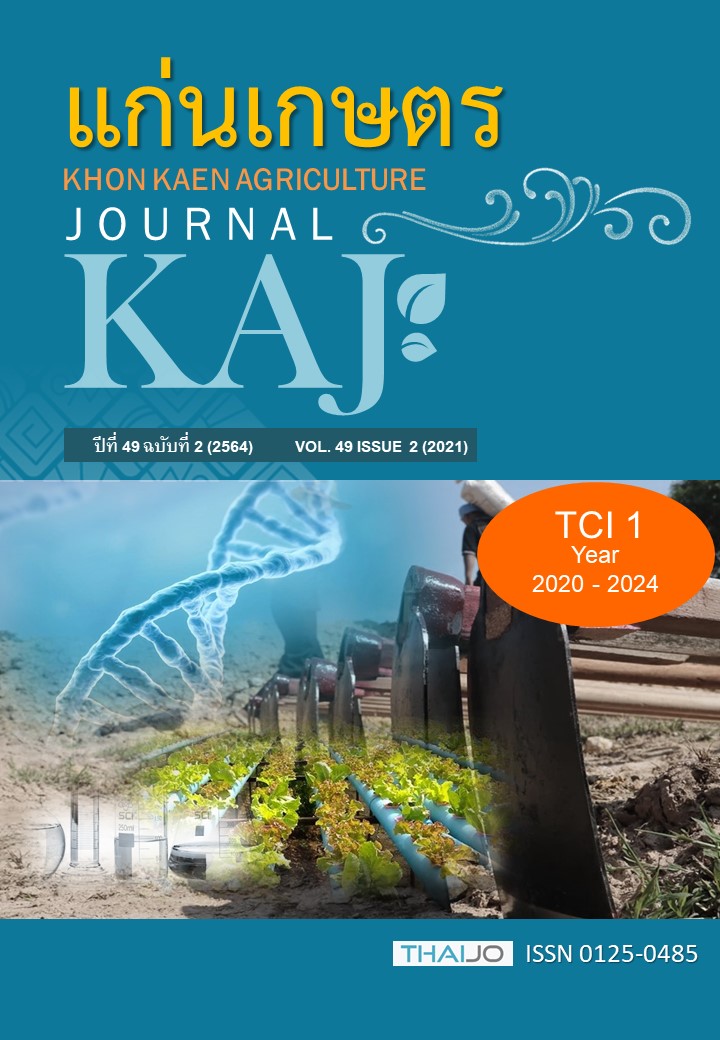กากถั่วดาวอินคาเพื่อเป็นแหล่งโปรตีนจากพืชชนิดใหม่ในอาหารปลาไน (Cyprinus carpio)
Main Article Content
บทคัดย่อ
กากถั่วดาวอินคา (sacha inchi meal, SIM) เป็นวัตถุดิบพลอยได้จากการบีบอัดน้ำมันแบบเย็นจากถั่วดาวอินคา และเป็นเศษเหลือได้ที่ยังคงมีสารอาหารที่สำคัญ ดังนั้นจึงเป็นที่มาของการวิจัยครั้งนี้ การศึกษาการทดแทนกากถั่วเหลืองด้วยกากถั่วดาวอินคาในอาหารปลาไนต่อการเจริญเติบโต ประสิทธิภาพการใช้สารอาหาร การเปลี่ยนแปลงเนื้อเยื่อวิทยา และต้นทุนค่าอาหาร การทดลองนี้กำหนดให้อาหารสูตรควบคุมมีแหล่งโปรตีนหลักจากกากถั่วเหลือง เปรียบเทียบกับอาหารที่ทดแทนด้วยแหล่งโปรตีนจากกากถั่วเหลืองด้วยโปรตีนจากกากถั่วดาวอินคาในระดับที่เท่ากัน โดยกำหนดให้อาหารทดลองทั้งหมดมีโปรตีนในระดับที่ใกล้เคียงกัน 30 % (isonitrogenous diets) และระดับไขมัน 10 % (isolipidic diets) เพื่อทดสอบในปลาไนที่มีน้ำหนักเริ่มต้นเฉลี่ยเริ่มต้น 7.01 ± 0.01 กรัม/ตัว เป็นเวลา 10 สัปดาห์ จากการศึกษาพบว่าปลาไนที่ได้รับอาหารที่ใช้กากถั่วดาวอินคาเป็นหลักมีอัตราการเจริญเติบโต น้ำหนักที่เพิ่มขึ้นต่อวัน อัตราการเจริญเติบโตจำเพาะ อัตราการกินอาหาร ประสิทธิภาพการใช้โปรตีน โปรตีนที่นำไปใช้ประโยชน์ การเก็บรักษาโปรตีน และไขมันสูงกว่าอาหารสูตรควบคุมแต่ไม่มีความแตกต่างกัน (P > 0.05) ในขณะที่ดัชนีตับมีค่าที่สูงกว่า (P < 0.05) อาหารสูตรควบคุม ส่วนปลาที่ได้รับอาหารสูตรควบคุม พบการเปลี่ยนแปลงทางเนื้อเยื่อวิทยา โดยแวคคิวโอลของเซลล์ตับมีขนาดใหญ่แต่ไม่พบการเปลี่ยนแปลงในปลาที่ได้รับอาหารผสมกากถั่วดาวอินคาเป็นหลัก นอกจากนี้ปลาที่ได้รับอาหารที่มีกากถั่วดาวอินคาเป็นหลักมีความยาวของไมโครวิลไลของสำไส้ส่วนต้นที่ยาวกว่าปลาที่ได้รับอาหารสูตรควบคุม (P < 0.05) แต่ไม่มีความแตกต่างกันของไมโครวิลไลในลำไส้ส่วนท้าย (P > 0.05) ในขณะที่เนื้อเยื่อไตไม่พบการเปลี่ยนแปลงของปลาทั้งสองกลุ่ม การทดลองนี้แสดงให้เห็นว่ากากถั่วดาวอินคาสามารถทดแทนโปรตีนจากกากถั่วเหลืองได้ทั้งหมดโดยไม่มีผลต่อการเปลี่ยนแปลงทางเนื้อเยื่อวิทยา และนอกจากนี้ยังส่งเสริมการเจริญเติบโต การใช้สารอาหาร และสามารถลดต้นทุนการผลิตอาหาร
Article Details

อนุญาตภายใต้เงื่อนไข Creative Commons Attribution-NonCommercial-NoDerivatives 4.0 International License.
เอกสารอ้างอิง
วิชมณี ยืนยงพุทธกาล, สิริมา ชินสาร และนิสานารถ กระแสร์ชล. 2562. ผลของสภาวะการอบต่อการคงอยู่ของกลิ่นถั่ว และสมบัติทางเคมีของแป้งถั่วดาวอินคา. พระจอมเกล้าพระนครเหนือ. 29: 135-144
ศูนย์เทคโนโลยีสารสนเทศและการสื่อสาร. 2560. ระบบสารสนเทศการผลิตทางด้านเกษตร Online. แหล่งข้อมูล: http://production.doae.go.th/ 8hog, ค้นเมื่อ 27 กรกฏาคม 2563.
AOAC 1990. Official Methods of Analysis. Washington. DC: AOAC (Association of Official Analytical Chemists).
Araujo-Dairiki, T., F. Chaves, and J. Dairik. 2018. Seeds of sacha inchi (Plukenetia volubilis, Euphorbiaceae) as a feed ingredient for juvenile tambaqui, Colossoma macropomum, and matrinxã, Brycon amazonicus (Characidae). Acta Amazonica. 48: 32-37.
Boonyaratpalin, M., P. Suraneiranat, and T. Tunpibal. 1998. Replacement of fish meal with various types of soybean products in diets for the Asian Seabass, Lates calcarifer. Aquaculture. 161: 67-78.
Borba, M., D. Fracalossi, and L.Pezzato. 2006. Dietary energy requirement of piracanjuba fingerlings, Brycon orbignyanus, and relative utilization of dietary carbohydrate and lipid. Aquaculture Nutrition. 12: 183–191.
Chirinos, R., G. Zuloeta, R. Pedreschi, E. Mignolet, Y. Larondelle, and D. Campos. 2013. Sacha inchi (Plukenetia volubilis): A seed source of polyunsaturated fatty acids, tocopherols, phytosterols, phenolic compounds and antioxidant capacity. Food Chemistry. 141: 1732–1739.
Deyab, M., and M. Magdy. 2003. Replacement of fish meal with a mixture of different plant protein sources in juvenile Nile tilapia, Oreocromis niloticus (L.) diets. Aquaculture Research. 34: 1119-1127.
Fu, S. 2005. The growth performance of southern catfish fed diets with raw, precooked cornstarch and glucoseat two levels. Aquaculture Nutrition. 11: 257–261.
Hanssen, H., and M. Hubsch. 2011. Sacha Inchi (Plukenetia volubilis L.) nut oil and its therapeutic and nutritional uses. Academic Press, San Diego.
Hertrampf, J., and F. Piedad- Pascual. 2000. Handbook on Ingredients for Aquaculture Feeds. Kluwer Academic Publishers, London.
Humason, G. 1972. Animal Tissue Technique. Freeman and Company. San Francisco.
Khieokhajonkhet, A., S. Klongchai, O. Maphum, and G. Kaneko. 2019. Lipid distribution patterns of nine commercial fish in Thailand. Aquaculture Research. 50(4): 1348-1360.
Liener, I. 1980. Factors affecting the nutritional quality of soya products. Journal of the American Oil Chemists' Society. 58: 406-415.
Lopez L. M., M. Flores-Ibarra., I. Banuelos-Vargas, M. A. Galaviz, and C. True. 2015. Effect of fishmeal replacement by soy protein concentrate with taurine supplementation on growth performance, hematological and biochemical status, and liver histology of totoaba juveniles (Totoaba macdonaldi). Fish Physiology and Biochemistry. 41(4): 921-936.
Mohapatra, M., N. Sahu, and A. chaudhari. 2003. Utilization of gelatinized carbohydrate in diets of Labeo rohita fry. Aquaculture Nutrition. 9: 189–196.
Mumford, S., J. Heidel, C. Smith, J. Morrison, B. MacConnell, and V. Blazer. 2007. Fish histology and histopathology. U.S. Fish and Wildlife Service. National Conservation Training Center, U.S.A.
Robinson, E. 1991. Improvement of cottonseed meal protein with supplemental lysine in feeds for channel catfish. Journal of Applied Aquaculture. 1: 1-4.
Rumsey, G., S. Hughes, and R. Winfree. 1993. Chemical and nutritional evaluation of soya protein preparations as primary nitrogen sources for rainbow trout (Oncorhynchus mykiss). Animal Feed Science and Technology. 40: 135-151.
Rumsey, G., A. Siwicki, D. Anderson, and P. Bowser. 1994. Effect of soybean protein on serologicals response non-specific defense mechanism, growth and protein utilization in rainbow trout. Veterinary Immunology and Immunopathology. 41: 323-339.
Saroat R., M. Dena, K. Sunantha, and P. Suphat. 2016. Chemical properties and nutritional factors of presse cake from tea and sacha inchi seeds. Food Bioscience. 15: 64-71.
Sarunya P., W. Tinnungwattana and W. Chuapoehuk. 1997. Pond feeding of nile tilapia, Oreochromis niloticus (Linn.) with irradiated and dried activated sludge from the beer industry. Thai Journal of Agricultural Science. 30(3): 389-397.
Stone, D. 2003. Dietary carbohydrate utilization by fish. Reviews in Fisheries Science. 11: 337–369.
Sukkasame, N. 2000. Effects of palm kernel cake levels on growth performance of Nile tilapia (Oreochromis niloticus Linn.) M.S. Thesis. Songkla University, Songkhla.
Van den lngh, T., A. Krogdahl, J. Olli, H. Hendriks, and J. Koninkx. 1991. Effects of Soybean containing diets on the proximal and distal intestine in Atlantic salmon (Salmo salar): a morphological study. Aquaculture. 94: 297-305.
Watanabe, T., and J. Pongmaneerat. 1993. Potential of soybean meal as a protein sources in extruded pellets for rainbow trout. Nippon Suisan Gakkaishi. 59: 1415-1423.
Yueming, D. 1992. The use of soy bean protein in aqua feed. Netherlands: ADM Specialty Ingredients Division Stationsstraat.


